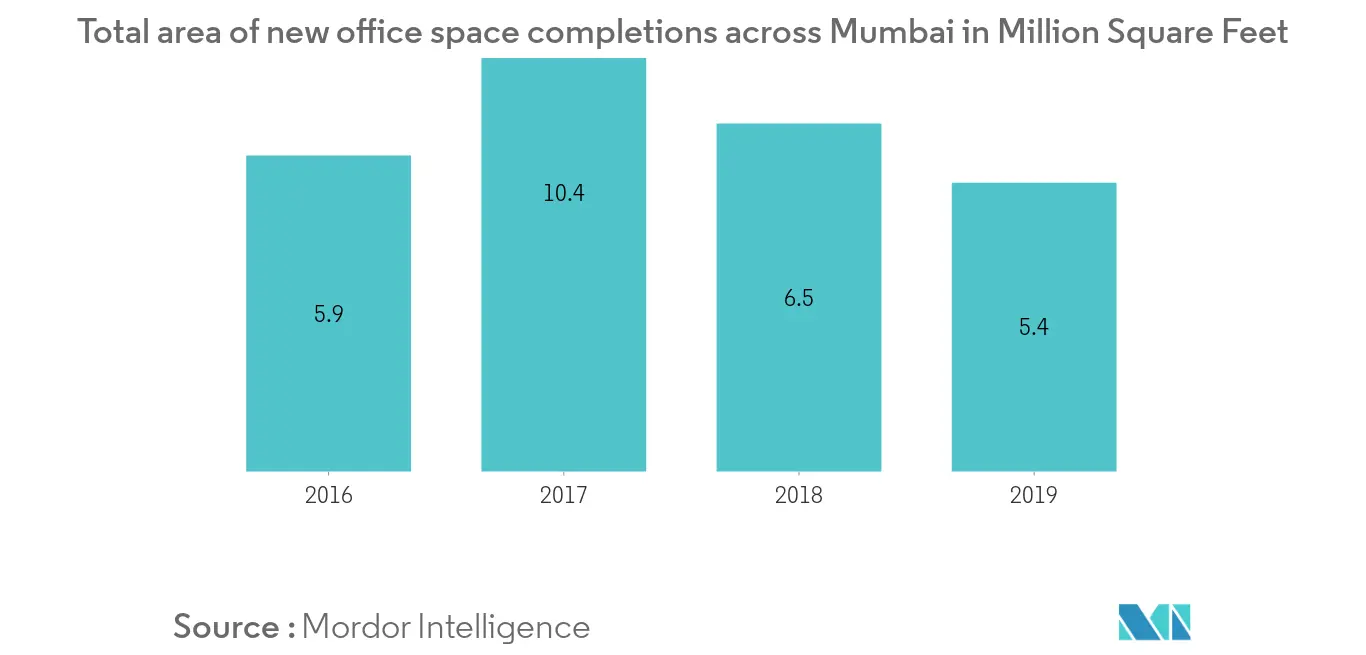Market Trends of India Commercial Construction Industry
This section covers the major market trends shaping the India Commercial Construction Market according to our research experts:
Growth in Commercial Space Market unaffected
Across the major metropolitans, including Delhi-NCR, Hyderabad, Bangalore, Chennai, Mumbai, Ahmedabad and Pune, office space absorption has been showing a jump year on year, in the past 5 years. Despite last quarter of the Financial Year, 2020, resulting in an economic slowdown and decrease in the absorption of Grade A office spaces by 30% (as per reputed and trustable sources), the net absorption has been higher as compared to the previous F.Y. Though, market experts have been expecting a decrease in the office space absorption by around 15%, post Covid-19 breakout, complementary decrease in supply due to labor shortages and Government regulations, is bound to occur. As a result, the sync in demand-supply is being expected to prevail, and the incumbent revision in rentals or changes in rental contract terms is not expected. It is worth mentioning that the decreased demand is mainly because US-based companies, which typically lease between 40-50% of annual net offtake of office space, are the biggest occupiers in the country, followed by local companies that occupy nearly 30%, while Europe, one of the worst affected by Covid-19, contribute 10% of the overall leasing in the Indian office market. Despite an expected decline in demand and supply, net demand of office space in 2020, is still expected to be well over the past 5-year average, backed by significant pre-booking or pre-leasing of space by occupiers.
Further, commercial retail space in shopping malls, office space in IT Parks, are set to face a major improvement, due to the Real Estate Investment Trust (REIT) coming into picture, resulting in increased flow of investments. DLF-GIC Joint venture, a private REIT, is a good example, and is expected to increase investments worth several Hundreds of USD Million in the commercial space market of the country.

Government Initiatives backed by Foreign Investments driving the Industry:
Five key regulatory reforms that are impacting Commercial Construction market growth are, Real Estate Regulation and Development Act (2016), resulting in increased transparency; Ind AS 115, an Indian Accounting Standard that directs the reality firms to shift from percentage completion to project completion, though its restraining effect is expected to be short term, till developers get adjusted; Insolvency and Bankruptcy Code, which urges stakeholders to settle bad loans, resulting in direct benefit to the industry; establishment of Real Estate Investment Trusts (REITs), which aim at raising avenues for generating finance and alternate investments; Goods And Services Act (GST), having mixed Impact on the suppliers and buyers. Besides, 100% FDI in construction sector under automatic route is permitted in completed projects for operations and management of townships, malls/shopping complexes, and business constructions which is a significant reason behind the fact that construction sector has proven to be a major FDI recipient sector for India.
Ample amount of construction opportunities have been floated in the market by the Government of India as a result of various development schemes like Make in India, Smart Cities Mission, Swachh Bharat Mission, Pradhan Mantri Awas Yojana, Atal Mission for Rejuvenation and Urban Transformation (AMRUT), National Heritage City Development and Augmentation Yojana (HRIDAY), Industrial Corridors Development, Modified Industrial Infrastructure Upgradation Scheme, Mega Ports Development, Railway Stations Development/ Re-development & Railway Line addition, and Infrastructure Debt Funds, resulting in growth across various construction segments, including commercial construction. Further, Government initiatives, diluting monetary commitments for the middle class and easing the liabilities have increased the mass investment for the public development schemes, including retail and contributions towards commercial complex spaces. In this regard, Real Estate Regulation and Development Act 2016 and GST Regime Implications, Model Guidelines for Development and Regulation of Retirement Homes are significant. All these initiatives could prove to be helpful in the post COVID-19 outbreak, where experts are predicting a slowdown due to lower revenues and labor shortages.
Moreover, besides the market trends, Sustainable Building, Green Building, Construction Equipment, Construction Vehicle Segments are the major Industry Trends leading to Commercial Construction Market growth.


